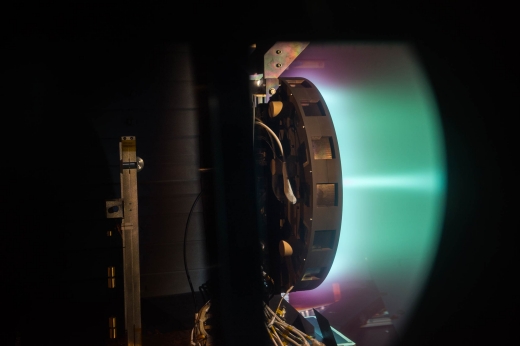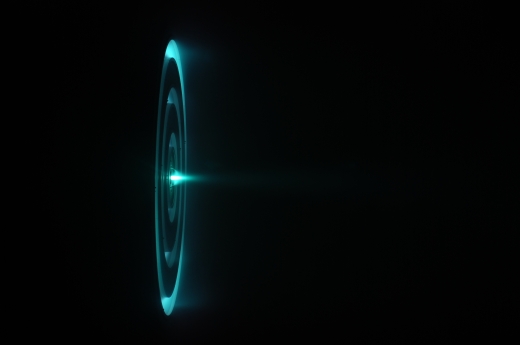Although I want to start the week by looking at hybrid propulsion technologies, let’s start by considering developments in ion propulsion before going on to see how they can be adapted for future deep space missions. Hall thrusters are a type of ion engine that uses electric and magnetic fields to manipulate inert gas propellants like xenon. The electric field turns the propellant into a charged plasma which is then accelerated by means of a magnetic field [see reader ‘Supernaut’s correction to this in the comments below].
We’ve seen the benefits of ion engines in missions like Dawn, which has recently received a second mission extension to continue its work around the asteroid Ceres. Now we learn that a Hall thruster called X3, developed at the University of Michigan by Alec Gallimore, has received continuing design modification by researchers at NASA Glenn and the US Air Force, scaling up the low thrust levels produced by conventional ion engines. A series of tests have demonstrated results that have implications for future manned space missions.
In fact, the X3 breaks all previous Hall thruster records, producing 5.4 newtons of force compared with the earlier 3.3 newtons. As noted in this University of Michigan news release, the X3 design also doubles the operating current record, reaching 250 amperes vs. 112 amperes, while running at slightly higher power levels than previous designs. A Hall thruster with higher power and improved thrust levels could shorten travel times, a significant factor as we work to mitigate radiation problems for human crews on long interplanetary missions.
At Glenn Research Center, doctoral student Scott Hall (University of Michigan) worked with NASA’s Hani Kamhawi on experiments to test the improved thruster, using the only vacuum chamber in the United States large enough to cope with the X3’s exhaust, even though the sheer amount of xenon can still cause some of it to drift back into the plasma plume, affecting the results. An upgraded vacuum chamber at the University of Michigan should be ready in early 2018.

Image: A side shot of the X3 firing at 50 kilowatts. Credit: NASA.
The work at Glenn involved four weeks to set up the thrust stand, mount and connect the thruster with propellant and power supplies, deploying a custom thrust stand to bear the X3’s weight. 25 days of testing then produced the results above in a project funded by NASA’s Next Space Technologies for Exploration Partnership. The next step here will be to integrate the X3 with power supplies now being developed by Aerojet Rocketdyne. By the spring of next year, new tests at NASA Glenn using the Aerojet Rocketdyne power processing system are expected.

Image: The X3 nested-channel Hall thruster with all three channels firing at 30 kW total discharge power. Credit: University of Michigan.
These developments in current Hall thruster technology are exciting in themselves and have implications for the near-term in missions to destinations like Mars. But I’m also interested in pursuing how we might move ion technologies in new directions by creating hybrid designs, with Kuiper Belt objects and the gravitational focus at 550 AU as potential destinations. With laser methods now in the spotlight as Breakthrough Starshot continues its analysis of a mission to Proxima Centauri, hybrid ion engine designs boosted by laser power are coming into consideration. I’ll take a look at the possibilities in tomorrow’s post.



You could say that Scott . . . found his Halling.
Would be interesting to see what coupling this with a small space capable fission reactor ala NASA’s KiloPower ( actually being tested this year https://ntrs.nasa.gov/search.jsp?R=20170002010 ), thrusting for decades, would allow in the way of unmanned deep space probes, with technology we have hand essentially “now”.
Curious, this thruster uses up to 200 kWe of power. The KiloPower is limited to 10 kWe. The nominal mission for the X3 is a ~300 kWe solar electric mission to Mars in support of human exploration. The solar power is expected to be about 7-10 kg/kWe (at 1 AU). KiloPower is 145 kg/kWe. These values are inversely proportional to the acceleration of the propulsion system, so lower is better. Other more advanced nuclear technologies might reach better values, but not necessarily with the actual KiloPower technologies.
While the current KiloPower is targetted at 10kWe it is scalable and NASA has been looking at MegaPower which is up to 2mWe https://www.nextbigfuture.com/2017/07/very-small-modular-nuclear-fission-reactors-for-military-and-space-applications.html . I suggested this for deep space where available solar flux becomes greatly reduced, plus the large solar arrays present a large area for impact damage, especially if this will be travelling for decades.
My take was that the X3 has a thrust to weight ratio about an order of magnitude than the earlier X1. When running these engines in parallel to create higher thrust closer to chemical engines, they quickly become the dominant mass of the spacecraft. Thus reducing their mass for a given thrust is important when using them in this manner to improve efficiency of fuel use for delta v for transfer orbits.
One of the primary challenges for using this truster is NASA’s NOMMYD (not on my mission you don’t). It is so hard to get funding for a new mission in NASA that the program managers do not want to use new technologies unless they are mission critical. Goddard did experiments on electro-static ion propulsion 100 years ago. NASA did not use this technology on a science mission until after the Deep Space 1 technology demonstration mission in 1998. The Hall trusters were deveolped and used by the Russians long before the US finally flew some.
This Hall truster has 60 times the thrust of the DS1 engine which implies it likely to be used on much larger spacecraft. It may be a challenge to get the technology flight qualified for a major (heavy) outer planet mission.
Small correction: Dr. Alec Gallimore holds an endowed deanship titled the “Robert J. Vlasic Dean of Engineering”. Robert Vlasic himself did not participate in this research, as far as I can tell.
Thanks for that correction, Mike. Much appreciated!
Thank you for the excellent article. There’s a correction, however; you wrote
“The electric field turns the propellant into a charged plasma which is then accelerated by means of a magnetic field. ”
But it’s the other way around: the magnetic field ionizes the xenon, and the electric field is the one that accelerates outwards the ionized xenon, thereby producing thrust.
Thanks for that, Supernaut. I do seem to have turned things around!
I was under the impression that an electric current caused the gas to ionise and which was then ‘ion separated’ and then accelerated by the potential difference of the electric field. The magnetic field is there to protect and guide the very, very hot plasma.
Collisions with electrons in the discharge chamber (i.e., the circular, ‘blue’ regions in the image in this post) are what ionizes the xenon atoms. You’re right about the magnetic filed. Look for Hall-effect thruster in Wikipedia.
I have been wondering about vastly scaled-up ion engines (either gridded or Hall Effect thrusters) lately. In Willy Ley’s 1964 book “Beyond the Solar System” (which predicted a circa 2014 manned mission to Alpha Centauri, aboard a “deep-space craft” [maybe “starship” was too ‘science fiction-ey’ for his liking?]), Chesley Bonestell portrayed a cylindrical ship powered by one great big, mercury-fueled (with “drop tanks”), gridded ion engine at its rear (see: http://www.flickriver.com/photos/57440551@N03/24070579816/ , http://www.pinterest.com/pin/537617274238717827/ , and http://www.zeljezno-polje.com/beyond-the-solar-system.pdf [the whole book]), and:
Could gridded ion engines and/or Hall Effect thrusters be scaled up to such a large size, and would such large engines be advantageous? I can think of a few possible advantages:
[1] Such a large engine would need only one thrust structure (whereas a cluster of many small ones would each need its own, adding mass);
[2] If such an engine could–rather like the 18 burner cup V-2 rocket engine–utilize many smaller gridded ion thrusters (or Hall Effect thrusters) feeding into a single, large acceleration chamber (which could further accelerate the aggregate ion beam), it could have a higher exhaust velocity;
[3] Such a big engine would be modular, so that any malfunctioning or worn “feeder thrusters” could be removed for servicing or refurbishment (perhaps on a rotating schedule), without requiring the ship to stop accelerating (or decelerating, on approach to its destination), as it could continue under way, just at a slightly lower acceleration or deceleration while the “down modules” were being serviced, and:
[4] Even and thorough exhaust beam neutralization (all around the beam, unlike with smaller gridded and Hall Effect thrusters, which usually have just one neutralizer, mounted to one side) could easily be achieved by ringing the exhaust beam orifice with multiple electron guns (or even multiple hot cathode filaments). In addition:
ESA experiments with 4-grid ion thrusters (having two pairs of grids, one high-voltage, and one low-voltage [regular gridded ion thrusters have two grids]) showed that not only were higher exhaust beam velocities achievable, but that grid erosion could be greatly reduced, which lengthened the thruster life considerably. (Hall Effect thrusters also experience erosion of their “thrust channels,” although their service lives are satisfactorily long.)